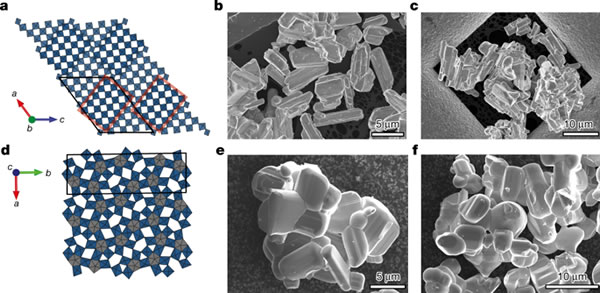Cambridge University develops new lithium battery materials to make fast charging safer
Researchers at Cambridge University have just identified a set of new materials that can be used to make higher power batteries. They found that lithium ions can pass through the complex microstructure formed by niobium-tungsten oxide materials at a speed far exceeding that of typical electrode materials, which means it can achieve faster charging speeds. In short, this discovery may become the key to building the next generation of lithium-ion batteries. They are expected to be fully charged in minutes (instead of hours) without dangerous overheating.

Research map-1: Crystal structure / particle morphology of Nb16W5O55 and Nb18W16O93
Since the 1990s, lithium-ion batteries have been continuously and widely used. Unfortunately, the increase in energy density is only 3 to 4% per year-far below the expectations of electric vehicle and consumer electronics manufacturers.
More importantly, these improvements usually come from the optimization of packaging materials, rather than the electrode itself. This strategy can hardly make up for another inherent shortcoming of battery technology-slow charging speed.
In order to increase the charging rate, it is necessary to speed up the flow of charged lithium ions from the positive electrode to the negative electrode. Scientists have been trying to achieve this goal by establishing special nanostructures inside the electrode:
This move aims to reduce the distance traveled by lithium ions, but your particles are tricky and expensive to use, and they also produce unnecessary chemical reactions, which shortens the life of the battery.

Research map-2: Electrochemical characteristics of two substances
In the latest findings of Cambridge University, the researchers adopted different methods:
It chose larger particles with rigidity and an open column structure. This structure allows lithium ions to move in large quantities without hindrance, thereby increasing their circulation by several levels.
New electrode materials can also be a safer alternative:
The negative electrode in most lithium-ion batteries is made of graphite. During high-speed charging, dendrites (ie, microstructures of lithium fibers) are formed.
Dendrites can cause short circuits and even fires in batteries, but Cambridge University ’s new electrode materials do not.

Research map-9: Expectation of bulk and bronze ternary niobium-tungsten oxide, and electrochemical comparison with binary niobium oxide.
Professor Clare Grey, senior research author, said:
In fast charging applications, security is a place that needs more attention. Such potential new materials are definitely worth a look, because we need a safer alternative than graphite.
In addition, nano-organizations require multiple steps to be too manufactured, resulting in problems such as extremely low output and scalability.
In contrast, niobium-tungsten oxide is simpler to manufacture and does not require additional chemicals or solvents. Of course, before putting into practical application, we still have a lot of work to complete.
Carbon Brush Market analyzed the Industry region, including the product price, profit, capacity, production, capacity utilization, supply, demand and industry growth rate etc. In the end, the report introduced new project SWOT analysis, investment feasibility analysis, and investment return analysis to 2021
The recent report on Carbon Brush market carbon-brush-marketthrows light on the various factors governing the market across the globe. The report, titled Carbon Brush assesses the growth of the Carbon Brush market and estimates the valuation of the overall market by the end of the forecast period. The report provides an overview of the market and lists down the key drivers and restraints which will affect the market during the forecast horizon. Analysis of Porter`s Five Forces on Carbon Brush market in the world has been mentioned in the report. The report also compiles insightful information about the key players in the market.
The report segments the Carbon Brush market in the globe on the basis of product types and end-use application segments. The report analyzes the entire value chain of the Carbon Brush market and forecasts the market size and revenue to be generated by each of the segments. Various micro- and macro-economic factors governing the global Carbon Brush market has been mentioned in the report. In globe, the present slow growth of the economy and the impact of the government`s latest initiatives have been taken into account while forecasting the growth of the Carbon Brush market in the region.
Hitachi Carbon Brush,Carbon Brush Physical Hitachi,Hitachi Hair Dryer Carbon Brush
Haimen Hailing Carbon Industry Co., Ltd. , http://www.carbonbrush-hl.com